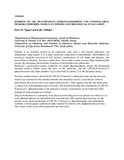Hybrids Of (2r, 3s)-n-benzoyl-3-phenylisoserine And Antimalarial Pharmacophores: Design, Synthesis And Biological Evaluation

View/
Date
2013-06Author
Njogu, Peter M
Chibale, Kelly
Type
PresentationLanguage
enMetadata
Show full item recordAbstract
Tubulin is an essential protein in all eukaryotic cells, and a well known anticancer
and anthelmintic drug target1. It is a major structural component of microtubules.
Microtubules are necessary organelles involved in cell division, maintenance of
cell shape and integrity, and intracellular trafficking. Previous studies have shown
that taxanes possess high antiplasmodial potency by disrupting microtubular
structures of intraerythrocytic plasmodia.
Paclitaxel, a prototypical taxane, comprises two major pharmacophoric groups:
the diterpenoid baccatin nucleus which forms the core of the molecule, and the
(2R,3S)-N-benzoyl-3-phenylisoserine side chain attached via an ester bond at
carbon 13 of the diterpene moiety.
Previous studies indicate that both the (2R,3S)-N-benzoyl-3-phenylisoserine and
the baccatin nucleus are essential for the antimicrotubular and anticancer activity
of paclitaxel, whereas individually they are devoid of any appreciable activity3.
This suggests that the side chain plays a critical role in the pharmacology of
taxanes. We hypothesized that the contribution of (2R,3S)-N-benzoyl-3-
phenylisoserine to the anticancer activity of paclitaxel can be replicated when
hybridized with antimalarial scaffolds.
Drug hybridization is a commonly used and successful drug discovery practice
in which two or more pharmacophores are hybridized into one molecule with
superior pharmacology. In the present work, molecular hybrids of (2R,3S)-
N-benzoyl-3-phenylisoserine with antimalarial scaffolds were designed,
synthesized and evaluated for their in vitro antiplasmodial activities. The results
of this work will be presented and discussed.
Citation
Njogu, Peter M., Chibale, Kelly;june,2013.Hybrids Of (2r, 3s)-n-benzoyl-3-phenylisoserine And Antimalarial Pharmacophores: Design, Synthesis And Biological Evaluation,presented at the 2nd International Scientific Conference, CHS And KNH, 19th - 21st June 2013.Publisher
University of Nairobi College of Health Sciences
Description
Hybrids Of (2r, 3s)-n-benzoyl-3-phenylisoserine And Antimalarial Pharmacophores: Design, Synthesis And Biological Evaluation,presented at the 2nd International Scientific Conference, CHS And KNH, 19th - 21st June 2013.
